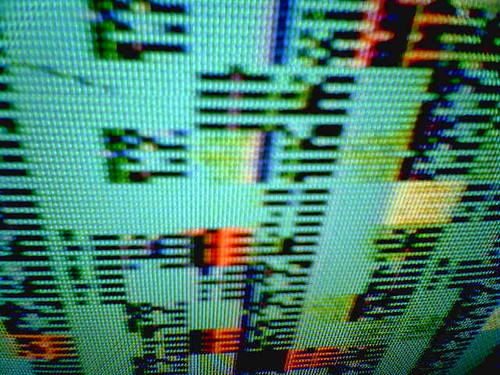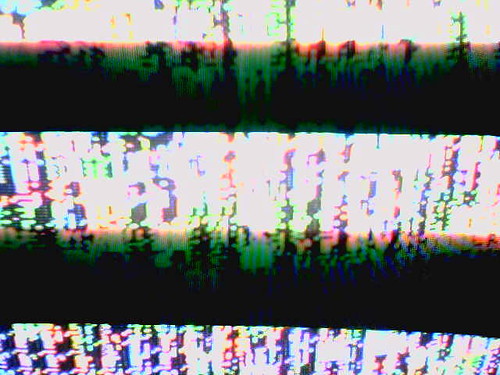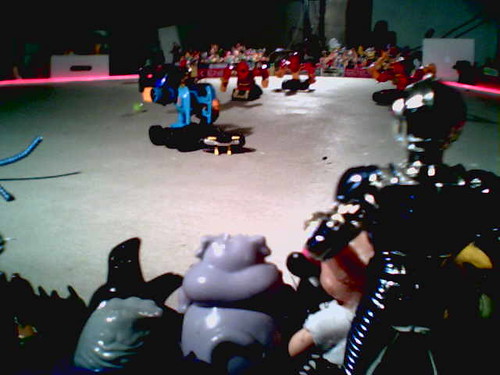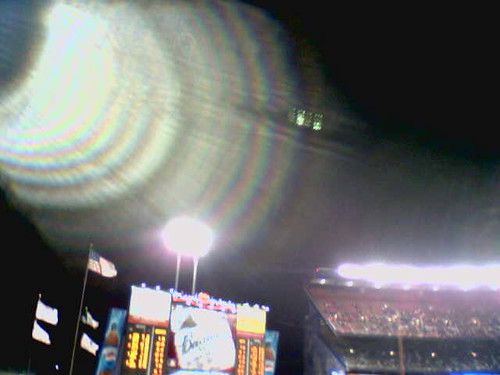I made my Associated Press debut today, with a story about last week’s circuit bending festival. It’s been picked up by the websites of (at least) 42 news organizations, including the Washington Post, Canada.com, the Chicago Tribune, and the Local News Leader in Olberlin, Kansas. Whee. I’m not sure if that means it’ll be the treeware editions, too, but maybe? For some reason, the San Jose Mercury News has filed it as “gossip.” If you haven’t looked at ’em yet, I posted some pictures, too.
MLB.com’s Gameday interface is a pretty ginchy way to follow a ballgame without the TV or radio interrupting work. The window automatically updates with a striking amount of information about the game as it happens (albeit with a 10-or-so second delay), all of which can be perceived in quick glances. Once one picks up the rhythm of the page reloads and toggling between other projects, the pace creates its own drama, and unfolds as such. Key transmissions, such as when runs score, come in bold. Today, I resisted the urge to turn on the radio as the Mets blew a lead in the bottom of the ninth, and beat the Giants in extra innings. It felt even more old-fashioned than radio, like reconstructing a game via telegraph.
Not sure if it’s still available, but XM Radio posted the first episode of the Theme Time Radio Hour With Your Host Bob Dylan (username: press1, password: xmr0ck5!). About a million miles from contemporary radio, it is exactly the type of show I would’ve loved to discover late at night in high school when I was supposed to be asleep. Where Dylan to come on, and were he just a random announcer and not actually Bob Dylan, I would’ve likely thought “who talks like this?” His phrases are occasionally awkward, his spoken recitations of songs’ lyrics kind of hilarious, and his attempt at introducing Stevie Wonder in Italian is endearing.
But I’m equally sure that I would’ve kept listening, because the DJ sounds like he’s from another planet. In a good way, too. “If you think the sun is too hot, at least you don’t have to shovel it,” he says near the end of the weather-themed episode. (“Spoken like a true Minnesotan,” a friend commented.)
The music is great, mostly drawn from that ancient period before, well, Dylan was Dylan. There’s Muddy Waters and the Carter Family, of course. But there’s also Frank Sinatra and Martin, Joe Jones’ proto-surf-rock (“California Sun”) and cinematic Judy Garland (Come Rain or Shine”). There’s calypso (Lord Beginner’s “Jamaica Hurricane”) and tremolo-kissed gospel (The Staples Singers’ “Uncloudy Day”). I can’t say I’m going to subscribe to XM just to get Dylan’s show, but I’ll certainly make an effort to track it down (and would probably even purchase it on a per-episode basis, were that option to be reasonably offered).
I interviewed Mike Love recently for the Middletown Times Herald-Record. They called it “Beach Boy Mike Love at West Point.” I like my headline better: “Unleash the Love.”
And a “hullo” to Times Herald-Record readers.
Please to be enjoying some other Beach Boys-related writing I’ve done.
o I Know There’s An Answer: Passing the Turing Test With Brian Wilson — Brian Wilson interview, circa December 2005.
o Endless Summer — Contemplating Endless Summer as a concept album on a snowy day.
o One Final Smile, part I, part II — Thoughts on Tim Smolen’s reconstructed Smile.
o Wouldn’t It Have Been Nice — My February 2004 Smile feature for Salon.com.

The following Brian Wilson interview (the most frustrating I’ve ever done) was supposed to have been published in December 2005, around the time of the release of Brian’s What I Really Want For Christmas holiday LP. It didn’t, and — as soon as the New Year rolled around and the album’s press cycle ended — it became instantly unsellable. Here ’tis.
I Know There’s An Answer: Passing the Turing Test With Brian Wilson
by Jesse Jarnow
Brian Wilson has a mindblowing deadpan. At least, that’s the most reassuring explanation.
Having unexpectedly returned to the critical and popular limelight last year with his resurrected 1966 masterwork Smile, the 63 year-old Wilson and his associates seemingly achieved the impossible. As if to affirm that assessment, Wilson has followed the final realization of his greatest accomplishment with its polar opposite: an infinitely unassuming, shinily packaged holiday CD titled What I Really Want For Christmas.
While it’s hyperbole to say (as Wilson’s website does) “that it’s not hyperbole to say that [Wilson’s new songs] are destined to become instant Christmas standards,” What I Really Want For Christmas — which includes a title collaboration with Elton John lyricist Bernie Taupin — is a must-have for anyone who thinks that both Christmas albums and the Beach Boys are pretty nifty ideas. (Others might need more convincing.)
When Wilson led the Beach Boys through the 1964 recording of the #6 charting Beach Boys’ Christmas, it was totally natural. For starters, they were family. Wilson co-founded the band with brothers Dennis and Carl, first cousin Mike Love, and neighbor Al Jardine. What’s more, they were an American family.
“We used to Christmas carol to our neighbors,” Wilson says simply.
What songs did they sing?
“I just remember singing Christmas carols.”
And who was there?
“My family.”
Any particular memories?
“No, we just had a lot of fun doing it.”
“The relationship between the Wilsons and the Loves was very similar to the Hatfields and McCoys,” Love reflected in 2000’s Endless Summer documentary, recalling the legendary Southern families who’d feuded so long that they’d forgotten the origins.
“But there was one time of year [our] families would get together and there was sort of a truce,” Love continued, “and that was Christmastime, when we would do all our Christmas carols and get together musically. After the carols were done, we’d segregate into age groups and do music that was of our time.”
Nowadays, remembering the causes of the Wilson/Love feud isn’t so tough. The Beach Boys’ decades of hits gave way to — like Wes Anderson’s Royal Tenenbaums — “decades of betrayal, failure, and disaster.”
The tension has never been far from the surface. During the ’60s, the two went face-to-face over the contents of the original Smile, and by the mid-’70s Wilson abandoned his band amid drug abuse and depression.
There was late brother Dennis’s marraige to (and child by) alleged Love daughter Shawn Marie Love, and the remaining Beach Boys’ 1991 battle to remove Brian from the care of svenghali psychiatrist Eugene Landy. And there was Love’s late ’90s squabble with Wilson over “Good Vibrations” royalties. Just in time for the holidays is Love’s latest lawsuit, this one over Smile (with some nasty words about Brian’s management on the side).
It’s no wonder that Wilson doesn’t want to speak of Christmases past. Is he going to revive the tradition for Christmases future with his family, which — in addition to grown daughters Carnie and Wendy — now includes three adopted daughters with wife, Melinda?
“No.”
Any reason?
“No, no reason, we’re just not going to.”
At its best, What I Really Want For Christmas evokes Christmas in southern California, plastic reindeer strung afront low-slung bungalows, tinsel wrapped about the drive-through at the burger shack. As he has the since ’60s, Wilson faces down pain with elaborately layered harmonies and bouncy organs.
Christmas — his third album in under two years — is the latest in Wilson’s most productive period since his prime. Besides constant touring, Wilson recently offered to personally telephone any fan that donated $100 or more to aid victims of Hurricane Katrina.
Did he have funny conversations?
“No.”
How many people did he talk to, anyway?
“About 10,” Wilson replies earnestly, with what one strongly hopes is extremely dry wit. (According to Wilson’s office, the pledge drive raised $210,000 in donations via over 500 phone calls by Wilson.)
Those tempted to apply British mathematician Alan Turing’s famed test to determine the difference between human and artificial intelligence would be frustrated. Publicly, anyway, Wilson has long championed harmony over intellect. But who needs to answer questions over the holidays when he can just sing, anyway? Surf’s up, mmmhmmhmm.
“Every Grain of Sand” (demo) – Bob Dylan (download here)
recorded in 1980
from Bootleg Series box set (1991)
released by Columbia Records (buy)
(file expires April 26th)
Given the quality of the work, it might not say a lot that “Every Grain of Sand” is easily my favorite Bob Dylan tune from the ’80s. Shot of Love, from 1981, is called Dylan’s first post-Christian album. But “Every Grain of Sand,” is still very much a religious song, albeit in a more nuanced, less evangelical way than his previous three records. “I hear the ancient footsteps, like the motion of the sea,” Dylan sings, “sometimes I turn, there’s someone there; other times, it’s only me.”
With its reverb-heavy guitars, the official Shot of Love version sounds a bit like a prom ballad, or maybe one of David Lynch’s attempts at noir pop. The demo, released on the inaugural Bootleg Series box set, is more palatable (and a bit faster). The sparse arrangement of Dylan’s piano and Fred Tackett’s guitar is just right. For reasons both topical and musical, I can easily imagine Sufjan Stevens covering this rendition of “Every Grain of Sand,” whispering the lyrics over Kermit-style banjo.
“The Lifting” – R.E.M. (download here)
from Reveal (2001)
released by Warner Bros. (buy)
(file expires on April 24th.)
Being warm out and all, I got some quality roof/sunset time in this weekend. It made me want to listen to Reveal, by R.E.M.. Post-Automatic For the People R.E.M. tends to get a raw deal, I think. Admittedly, the last album wasn’t great (though I owe it another listen), but I think Up and Reveal are legitimate — if modest — records. There are no anthems, but that’s not their place. “The Lifting” is Reveal‘s opener. As soon as Michael Stipe comes in and the chord changes become obvious, it is unmistakably R.E.M.. The whole album is like that: virtual orchestras and noise washes, but there’s never any confusing the band. It’s a unified, unique sound, I think, often hard to place individual instruments.
Like most of my favorite R.E.M. songs (as well as Astral Weeks by Van Morrison), I’ve rarely stopped to think about the lyrics. I can sing along to “The Lifting,” I think (ditto for most of Automatic), but with few exceptions the songs have never cohered into complete thoughts or stories. Key words and phrases get lodged in my head: “seminar,” “sunken cities,” “the air was singing.” I have always associated this song with transcendence in the Sprawl. I think of gorgeous, late afternoon light hitting strip malls, chain restaurants, and parking lots. There is absolutely nothing in the lyrics to support this idea, but that’s what I love about Michael Stipe’s words: they tend to provoke nonsensical interpretations in me. They’re good carriers.
One way the Museum blurs facts into emotional half-truths is through atmosphere. Ostensibly, the Museum is devoted to the scientific, but the theatrical presentation is extraordinarily important. My favorite example is the squid vs. whale battle in the Hall of Ocean Life, where a fake whale battles a fake squid in a dark display case with no glass between the viewer and the subject. But that’s unphotographable, at least with my cell-a-roid.
A close second, and another childhood favorite, is the Gem Room (which I think is actually called the Gem Room). It is dark and circular, with all kinds of ramps and nooks and miniature amphitheaters and artifacts you can actually touch. As a kid, the room felt like a respite, with numerous places to hide and sit (a welcome break for a young biped). Despite the obstacle course Rachel and I had to cross to get there, it still felt that way. I love the vibe of the room.
A few years ago, I made an ambient sound collage out of very quiet FM static and drone-organ designed to be listened to in the Gem Room (as well as with the collection of meteorites next door). Oddly, I still haven’t actually listened to it there. It was called “A Clear Night.”

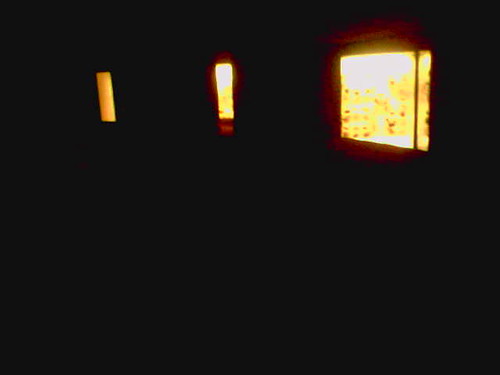

“Strange Invitation” – Beck (download here)
from Jack-ass single (1997)
released by DGC (buy)
(file expires on April 20th.)
Like “Brazil,” “Jack-ass” is also a durable song. Besides the Odelay version, based on Van Morrison’s cover of “It’s All Over Now, Baby Blue,” there’s “Burro,” the mariachi arrangement, and this, “Strange Invitation.” Given that Beck has since made it one of his trademarks, it’s also worth noting that this is probably first string-heavy space-pop ballad. (David Campbell, Beck’s father, arranged the strings in question.)
Like both other versions, “Strange Invitation” is gorgeous. For me, the center of the song is the phrase “we will rise in the cool of the evening.” It conjures up something out of One Hundred Years of Solitude, of seeking respite from an oppressive, exotic heat and finding it in the transcendent nighttime shade.
Museums, and especially the Museum of Natural History, are intended to be places of learning. We look at exhibits, read the labels, and are educated. But we are bombarded with facts, and they tend to blur into glorious half-truths. On the mezzanine of the Hall of Ocean Life (what my inner seven-year old still calls “the underwater room”), there are a bunch of dioramas of what the bottom of the ocean maybe/mighta/kinda looked like in a few different prehistoric ages (one of them being the Ordovician) in various places (one of them being an ocean over present-day Ohio). Dang if I can remember the actual facts, but I sure remember the wild colors. Have I been educated? Absolutely.

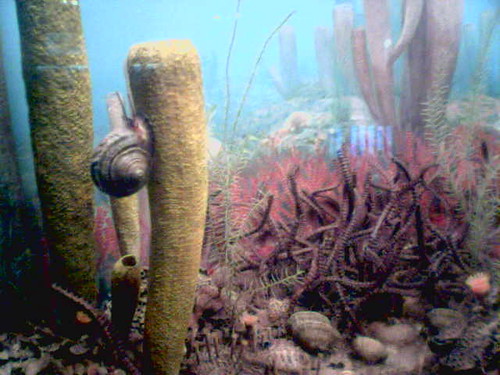

This week marks the release of AUX, a compilation organized by Ideas for Creative Exploration at the University of Georgia. It features a host of Elephant 6 conspirators — including Heather McIntosh (The Instruments), Will Hart (The Olivia Tremor Control/The Circulatory System), Hannah Jones (Lorkakar/Tuning the Air), and the long-awaited official debut of Korena Pang (do some Google searching)– as well as a host of other fine Athens-based musicians. I really like “Waiting For the Dawn to Break” by The Leapyear, an act I need check out more from.
With gorgeous, handmade artwork, AUX is truly a labor of love. I’m proud to have contributed an essay to their equally handmade website. To read it, enter the site, click through the AUX logo, wave the cursor until a map of Athens appears like Brigadoon, click, find the shadowed outline of the falling aeroplane, click again, and check out “Another Set of Flowers in the Museum.”
Last week, en route across town, a friend and I got stuck in rush hour traffic near Central Park. We hopped out of the cab, and walked across the park. Despite the warm weather, it was nearly deserted. The only people about were New York caricatures in garish jogging suits or walking hilarious dogs, all of us extras in a Woody Allen movie. Near the Sheep Meadow, the midtown skyline placid in the blue dusk, I felt transported to the timeless city that runs unchanging beneath the ever-shifting storefronts, advertisements, and neon. I might as well have been 12, visiting from Long Island. Today, the Museum of Natural History felt the same way.



(As Owen and I once discovered, while the other stuffed animals in the dioramas are posed vaguely naturally, the gemsbok simply stare disarmingly back. They almost break the fourth wall.)

“April Showers” – Marcos Fernandes (download here)
from phonography.org, vol. 1 (2001)
released by phonography.org
(file expires on April 14th.)
Good field recordings are deceptively hard to make, especially of things that are simple, like rainstorms or waves crashing. At least when I’ve tried, unexpected noises have always sullied the result: people talking in the next room, sudden gusts of wind at odd angles to the microphone, etc..
Marcos Fernandes’ “April Showers” is the Platonic rainstorm. Water pounds in sheets on the porch roof, its tempo and intensity changing subtly, and — midway through — dramatically. A sparser sub-network of percussive drips plays in oblique counter-rhythm to the main drone. Airplanes (I think) cut through the atmosphere far above, issuing parallel rumbles like enormous pieces of construction paper ripping in extreme slow motion.
Sometimes, even if it is April and supposed to rain, it’s good to listen in advance to the music you are about to hear.
Tonight at dorkbot, I saw NYU’s Jeff Han present on the multi-touch systems he has helped invent. These are touchscreens that expand their input from one finger to, in theory, an infinite amount. In his presentation, Han argued that the one-cursor/one-mouse model that computers have run on for decades is limiting. If he hadn’t insisted that the screens depicted in his videos were real, I would’ve sworn the clips were mock-ups.
Hands roamed a celestial desktop filled with photographs, effortlessly resizing them and sorting them at will; they soared over a GoogleEarth-like mapscape zooming in and tilting with mild finger twitches; they sculpted a virtual face as if it were clay; they danced across a MaxMSP-type environment, attaching sound widgets to oscillators, keyboards, drum machines; they played strange futuristic games; they navigated pure abstractions. I guess it’s kinda that whole virtual reality thing, huh? Whether or not it will ever catch on, it’s straight-up next level.
Here is a short overview video demonstrating the multi-touch project.
“Some Clouds Don’t” – Fred Frith (download here)
from Cheap at Half the Price (1983)
released by East Side Digital
reissued by ReR Megacorp/Fred Records (2004) (buy)
(file will expire on April 12th.)
Matt turned me onto avant-guitarist Fred Frith’s frickin’ fantastic Cheap at Half the Price several years back. I finally got my own unscratched copy in today’s post. It’d be cheap (at less than half the price) to compare the disc-opening “Some Clouds Don’t” to Brian Eno’s ’70s pop excursions (to which Frith himself contributed)… but I think I just did anyway. Like those albums, Cheap is a rare trip into vocal-based music. Frith’s ragged voice, lo-fi complexity, and tweeting keyboards are all cheekily charming. The harmonies are nice, and there’s something willfully naïve about the lead guitar playing that I like (especially coming from somebody as nimble as Frith). The whole album — recorded on a four-track with Frith playing most of the instruments and assembling all of the sound collages — is extraordinarily personable.
Once Upon A Time – Kahimi Karie with the Olivia Tremor Control
released by Polydor Japan (2000)
download here
(file expires on April 9th.)
I’m a pretty big Olivia Tremor Control fan, but somehow — until this past weekend — I totally missed the existence of Once Upon a Time. Yet, there it is, nestled in the discography over at elephant6.com. Recorded in 2000 backing Japanese singer Kahimi Karie and released on Polydor in her native country, the Olivias serve up five tracks of spaced-out psychedelia replete with concrété chaos, horns, violins, cosmic blurps, and everything else one might expect (save for the giant Beatles choruses).
In an odd convergence, a few months ago, I asked my now ex-neighbor to give me the strangest music on her iPod. She gave me some tracks by Kahimi Karie that she’d lifted from a Japanese teen’s mp3 collection. And, lo, they were strange. Funny to find out now that she’s both a protégé of Cornelius (another fave), and has worked with the Olivia Tremor Control. Bizarro headphone candy, for sure. Once again, a peculiar noise called the Olivia Tremor Control…
(I’m pretty sure this EP/mini-album was never released in the States. It sure doesn’t turn up on Amazon. If anybody’s got any beef with me circulating it, let me know.)


